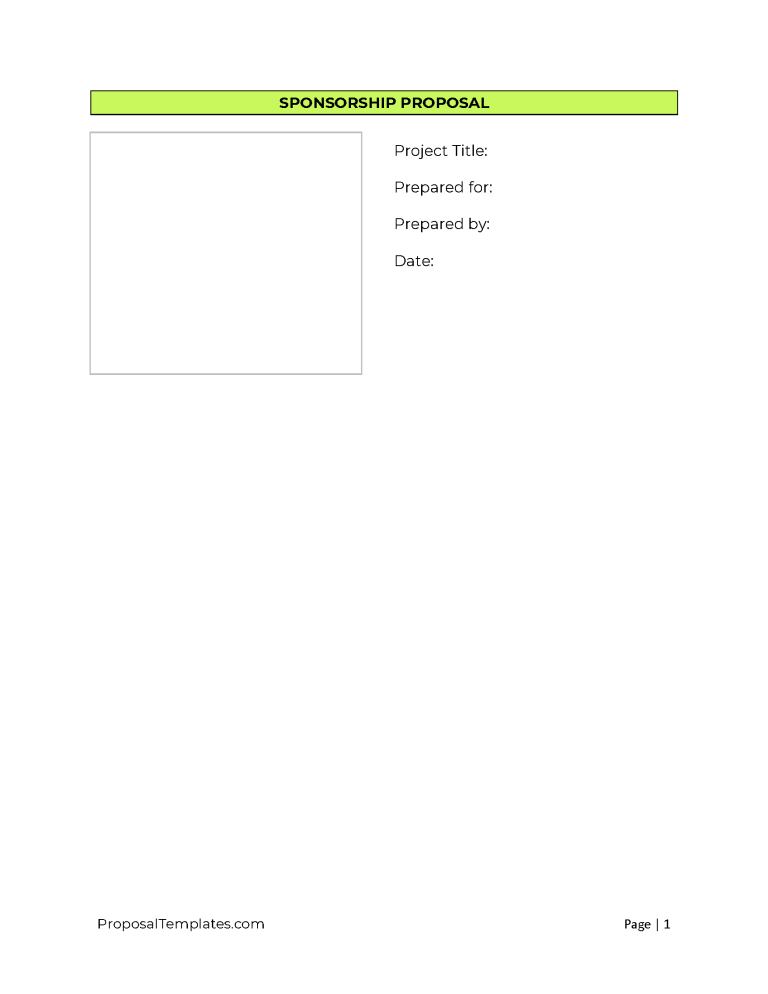A sponsorship proposal invites its recipients to fund or support a specific goal. While there are various types of sponsorship proposals, all will operate similarly to a sales proposal.
By Type (10)
- Academic Sponsorship Proposal
- Art Sponsorship Proposal
- Event Sponsorship Proposal
- In-Kind Sponsorship Proposal
- Local Community Sponsorship Proposal
- Media Sponsorship Proposal
- Nonprofit Sponsorship Proposal
- Partnership (Sponsorship) Proposal
- Product-Placement Sponsorship Proposal
- Sports Sponsorship Proposal
1. Sponsorship Proposal’s Title Page
Begin with a cover page that explicitly identifies as an invitation to sponsorship. Also, clearly display the proposal title, date, author, and the potential sponsor’s information.
Title, Date, Author
Sponsor Information
Logos, Graphics
Executive Summary
Table Of Contents
2. Executive Summary
Deliver a concise overview of the proposal’s sections, especially the highlights. Also, invite the sponsor to envision the benefits of sponsorship.
Event Overview, Sponsorship Opportunity
Target Audience, Previous Successes
Sponsorship Levels, Funding Requirements
Call To Action, Contact Information
Closing Statement
3. Introduction To Sponsorship
Introduce the purpose, event, project, or sponsorship initiative, as well as the entity behind this proposal. In addition, discuss the current sponsor’s situation in relation to the sponsorship.
Purpose, Background Information
Sponsorship Goals
Relationship With Sponsor
Engagement Opportunity
Call To Continue
4. Sponsorship Levels And Benefits
Specifically, discuss sponsorship levels and benefits. In fact, define each level while applying each benefit (i.e., Exposure, PR, VIP Access) to the potential sponsor’s status.
Title, Description, Benefits, Customization
Promotions, Social Media, Sponsor Progression
VIP Access, Networking Events
Brand Visibility, Value, ROI, Availability
Visual Representations, Contact Information
5. Target Audience
Discuss the sponsor audience (i.e., demographics, reach) since this will capture the client’s attention. Make a point of aligning the potential sponsor’s preferred target market with the sponsorship audience.
Demographics, Age, Gender, Location, Income
Size, Interests, Affiliations, Occupation
Value To Sponsors, Behavioral Characteristics
Audience Growth Potential, Engagement Level
Case Studies Or Testimonials
6. Event Or Project Details
Layout the sponsorship curriculum in detail. For example, describe the agenda, dates, and goals while promoting the event’s positive opportunities for the potential sponsor.
Event/Project Overview, Goals, Objectives
Event Or Project Timeline, Program, Agenda
Audience Engagement, Event Logistics
Promotion, Marketing, Partnership, Sponsorship Integration
Collaboration, Budget, Funding, Measurement, Evaluation
7. Previous Successes
Highlight prior sponsorship successes, especially when a sponsor’s status improved dramatically. In addition, cite past event sponsors of notoriety.
Title, Brief Description
Key Achievements, Audience Engagement
Sponsorship Outcomes, Testimonials, Endorsements
Visuals, Comparison
Lessons Learned, Relevance, Future Potential
8. Sponsorship Request
Now, make a formal request for the exact dollar amount of support sought from the potential sponsor. Specifically, describe all the factors contributing to this amount and its associated benefits.
Request Introduction, Financial Contribution
Sponsorship Benefits, Budget Allocation
Customization, ROI, Payment Terms
Recognition, Acknowledgment
Exclusivity, Sponsor Benefits
9. Marketing And Promotion Plan
Explain the branding and advertising techniques details of the sponsorship opportunity. For example, spell out the email marketing and social platform promotions for the sponsored event or purpose.
Overview, Target Audience, Marketing Channels
Content Strategy, Branding, Logo Placement
Engagement Activities, Timeline
Metrics, Analytics, Sponsor Visibility
Sponsor Engagement, Budget Supporting Materials
10. Custom Sponsorship
Describe the ways the training program can be tailored to the client’s objectives, particularly those with cost-saving measures. In fact, provide examples of any popular customizations if possible.
Client-Specific Content, Needs Anaylysis And Assessment
- Role-Specific Training, Company Culture, Values
- Sales Process Integration, Learning Preferences
- Language/Terminology, Scalability, Feedback Loop
- Module Flexibility, Customization, Timelines
11. Sponsorship Recognition
Present the publicity the potential sponsor will gain from this opportunity while displaying its promotional materials. Also, if possible, spell out any customizable opinions of the sponsorship publicity.
Acknowledgment, Branding, Exclusivity
Press And Media Coverage, Social Media Promotion
VIP And Hospitality, Customization, Measuring Impact
Community Engagement, Post-Event Acknowledgment
Visual Examples, Feedback, Approval
12. Testimonials Or References
Display testimonials (i.e., endorsements, anecdotes, recommendations) from previous sponsors. Also, document the contact information of earlier sponsors who will act as positive references.
Testimonials, Sources
Success Stories, Previous Sponsor Endorsements
Case Studies, Direct References
Visuals, Consent
Reference Source Information
13. Budget And Allocation
Display how the potential sponsor’s funds will be used for the event or purpose while encouraging them toward sponsorship. It is especially important this section discusses every contribution target.
Total Budget, Income Source, Reporting
Sponsorship Contribution, Contingencies
Expense Categories, Transparency
Funds Allocation, Accountability
Benefits To The Sponsor, Impact
14. Contact Information
Produce the sponsor contact’s information together with their availability. Prompt the potential sponsor to respond to this proposal with any questions or discussion because this may promote further positive communication.
Primary Contact, Email Address
Phone Number, Mailing Address, Website
Social Media Profiles, Preferred Contact Methods
Availability, Additional Contacts
Response Time, Language Preferences
15. Appendices
Gather the materials (i.e., media kits, contracts) accompanying this proposal. Also, include brochures and promotional materials for sponsorship.
Sponsorship Packages
Photos, Videos, Event Agendas
Case Studies, Testimonials, Media Coverage
Final Reports, Legal Documents, Additional Information
Contact Information, Permissions, Consents
16. Terms And Conditions Of Sponsorship
Supply a clear description of the terms, conditions, obligations, and agreements accompanying this proposal, as well as sponsorship. Make sure the potential sponsor understands the responsibilities together with the allowable expectations.
Parties, Scope, Duration, Payment Terms
Deliverables, Exclusivity, Cancellation, Termination
Intellectual Property, Confidentiality, Liability, Indemnity
Force Majeure, Governing Law, Amendments
Signatures, Attachments, Exhibits, Contact Information
17. Sponsorship Acceptance
Display a signature area where the author and potential sponsor may execute this proposal. The potential sponsor must sign this proposal as well as every other required agreement to progress.
Acceptance Statement, Acceptance Process
Confirmation Details, Payment Instructions
Receipt Acknowledgment, Contact Information
Signature Line, Terms, Conditions
Next Step, Gratitude

